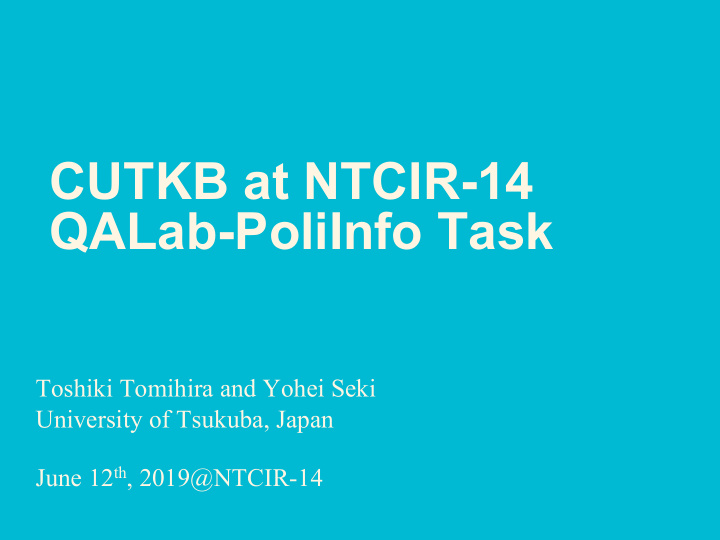



CUTKB at NTCIR-14 QALab-PoliInfo Task Toshiki Tomihira and Yohei Seki University of Tsukuba, Japan June 12 th , 2019@NTCIR-14
INDEX 1. Motivation 2. Classification task 3. Our approach 4. Evaluation results 5. Summary
1.Motivation Motivation The rise of social media -> democratized content creation and has made it easy for everybody to share and spread information online. ON POSITIVE SIDE We enable much faster dissemination of information compared to what was possible with newspapers, radio, and TV. ON NEGATIVE SIDE Stripping traditional media from their gate-keeping role has left the public unprotected against the spread of misinformation , which could now travel at breaking-news speed over the same democratic channel.
1.Motivation Background (1) The graph shows the results for the spread of true, false, mixed rumors using Twitter dataset [Vosoughi et al., 2018]. [Vosoughi, Roy, and Aral. Science 2018.] False news reached at more people and diffused faster than the truth. Soroush Vosoughi, Deb Roy, and Sinan Aral. 2018. The spread of true and false news online. Science, 359(6380):1146–1151.
1.Motivation Background (2) [Vosoughi, Roy, and Aral. Science 2018.] Much politics rumors are in circulation, but less true. →Fake news has become a social problem. Soroush Vosoughi, Deb Roy, and Sinan Aral. 2018. The spread of true and false news online. Science, 359(6380):1146–1151.
INDEX 1. Motivation 2. Classification task 3. Our approach 4. Evaluation results 5. Summary
2.Classification task Task Definition Goal To find “opinion with a factual verifiable basis” from politician’s utterance. Inputs and outputs Inputs: “Topics” and “Politicians’ utterance” Output: labels for three attributes Labels 1. Relevance: 0 or 1 2. Fact-checkability: 0 or 1 3. Stance: support, against or other
2.Classification task Label Examples Fact- ID utterance Relevance Stance checkability I do not agree with the transfer of the new bank Tokyo 1 TRUE FALSE against or the Tsukiji market. The Tokyo Metropolitan Government conducted 2 construction work on soil contamination of Toyosu on TRUE TRUE other August 30th. Toyosu is an area where visitors can expect customers 3 TRUE TRUE support by new market relocation.
INDEX 1. Motivation 2. Classification task 3. Our approach 4. Evaluation results 5. Summary
3. Our approach Our approach Fact-checkability →LSTM+CNN Relevance → LSTM Model of two input Stance → Simple LSTM Model
3. Our approach Approach: Fact-checkability Blue underline : important verbs to confirm factuality. Green underline : fact checkable parts. Red underline : clauses shared between documents. Common clauses or words between documents are important clues → LSTM + CNN
3. Our approach Approach: Fact-checkability Improve judgment by performing convolution and time series prediction: • The relationship between the minutes could be taken into consideration as a substitute for evidence. We compared two models using validation dataset: • Combine LSTM and CNN models. • LSTM model only. Combined models are better!
3. Our approach Approach: Fact-checkability
3. Our approach Approach: Relevance • Binary classification task: “relevance” or “irrelevance” • Inputs: “Topic” and “Utterance” We defined optimizer as Manhattan distance between two LSTMs obtained from “ Topic ” and from “ Utterance ” . Manhattan distance
3. Our approach Approach: Relevance
3. Our approach Approach: Stance We use simple LSTM model for classifying “support”, “disapproval”, and “no matter” classes. • Loss function: sparse categorical cross-entropy • Activation function: ReLU
3. Our approach Approach: Stance
INDEX 1. Motivation 2. Classification task 3. Our approach 4. Evaluation results 5. Summary
4.Evaluation results Results: Fact-checkability The recall & precision scores were higher with the gold standard N3: • all three assessors gave the common correct answers. -> The results regardless of people will be identifiable with our approach. N1: one or more; N2: two or more assessors; N3: three or more; SC: the weight of the correct score;
4.Evaluation results Results: Fact-checkability The result of Fact-checkability was stably superior. We confirmed that the model using LSTM and CNN is effective. Classification results for task participants existence absence team A R P R P KSU-08 0.735 0.407 0.722 0.914 0.738 CUTKB-04 0.730 0.523 0.647 0.843 0.764 RICT-07 0.729 0.419 0.694 0.899 0.738 TTECH-10 0.719 0.176 0.500 0.931 0.743 akbl-01 0.708 0.438 0.626 0.857 0.736 tmcit-01 0.652 0.630 0.507 0.665 0.766
4.Evaluation results Results: Relevance Problem → overfitting The topic of training data has only a few patterns. Solution in future Using skip-gram trained with Wikipedia corpus.
4.Evaluation results Results: Stance The score is low due to the data shaping problem of the submission data. ↓ fixed(not change model) The results improved, but still imbalanced.
INDEX 1. Motivation 2. Classification task 3. Our approach 4. Evaluation results 5. Summary
5. Summary Summary and future work • It was clarified that both convolution and sequence operations were necessary to estimate the fact-checkability. • From the data set, we confirmed that the sentences including the fact checkable information shared similar facts with the target sentences provided in the task. • We need to adjust the models for Relevance and Stance tasks in future.
Recommend
More recommend